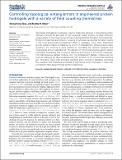| dc.contributor.author | Tang, Shengchang | |
| dc.contributor.author | Olsen, Bradley D | |
| dc.date.accessioned | 2017-06-08T18:00:41Z | |
| dc.date.available | 2017-06-08T18:00:41Z | |
| dc.date.issued | 2014-05 | |
| dc.date.submitted | 2014-03 | |
| dc.identifier.issn | 2296-2646 | |
| dc.identifier.uri | http://hdl.handle.net/1721.1/109749 | |
| dc.description.abstract | Topological entanglements between polymer chains are achieved in associating protein hydrogels through the synthesis of high molecular weight proteins via chain extension using a variety of thiol coupling chemistries, including disulfide formation, thiol-maleimide, thiol-bromomaleimide and thiol-ene. Coupling of cysteines via disulfide formation results in the most pronounced entanglement effect in hydrogels, while other chemistries provide versatile means of changing the extent of entanglement, achieving faster chain extension, and providing a facile method of controlling the network hierarchy and incorporating stimuli responsivities. The addition of trifunctional coupling agents causes incomplete crosslinking and introduces branching architecture to the protein molecules. The high-frequency plateau modulus and the entanglement plateau modulus can be tuned by changing the ratio of difunctional chain extender to the trifunctional branching unit. Therefore, these chain extension reactions show promise in delicately controlling the relaxation and mechanical properties of engineered protein hydrogels in ways that complement their design through genetic engineering. | en_US |
| dc.description.sponsorship | Massachusetts Institute of Technology. Institute for Soldier Nanotechnologies (W911NF-07-D-0004) | en_US |
| dc.language.iso | en_US | |
| dc.publisher | Frontiers Media S.A. | en_US |
| dc.relation.isversionof | http://dx.doi.org/10.3389/fchem.2014.00023 | en_US |
| dc.rights | Creative Commons Attribution 4.0 International License | en_US |
| dc.rights.uri | http://creativecommons.org/licenses/by/4.0/ | en_US |
| dc.source | Frontiers in Chemistry | en_US |
| dc.title | Controlling topological entanglement in engineered protein hydrogels with a variety of thiol coupling chemistries | en_US |
| dc.type | Article | en_US |
| dc.identifier.citation | Tang, Shengchang and Olsen, Bradley D. “Controlling Topological Entanglement in Engineered Protein Hydrogels with a Variety of Thiol Coupling Chemistries.” Frontiers in Chemistry 2, no. 23 (May 2014): 1-11 © 2014 Tang and Olsen | en_US |
| dc.contributor.department | Massachusetts Institute of Technology. Department of Chemical Engineering | en_US |
| dc.contributor.mitauthor | Tang, Shengchang | |
| dc.contributor.mitauthor | Olsen, Bradley D | |
| dc.relation.journal | Frontiers in Chemistry | en_US |
| dc.eprint.version | Final published version | en_US |
| dc.type.uri | http://purl.org/eprint/type/JournalArticle | en_US |
| eprint.status | http://purl.org/eprint/status/PeerReviewed | en_US |
| dspace.orderedauthors | Tang, Shengchang; Olsen, Bradley D. | en_US |
| dspace.embargo.terms | N | en_US |
| dc.identifier.orcid | https://orcid.org/0000-0003-0589-0965 | |
| dc.identifier.orcid | https://orcid.org/0000-0002-7272-7140 | |
| mit.license | PUBLISHER_CC | en_US |
